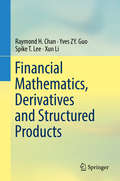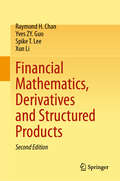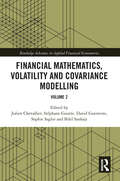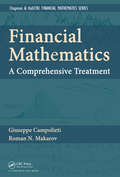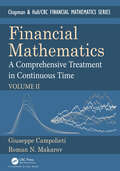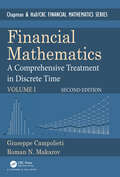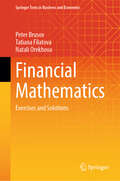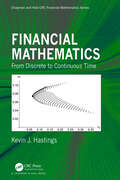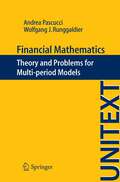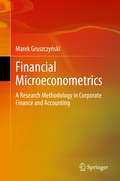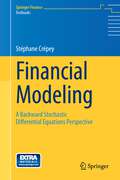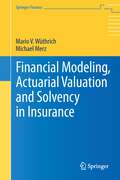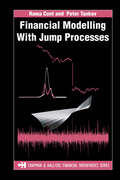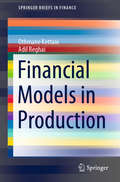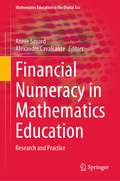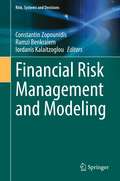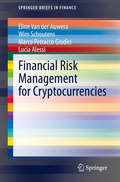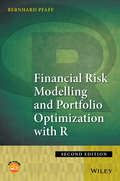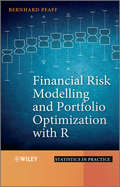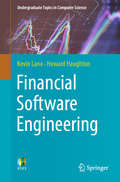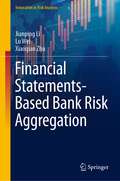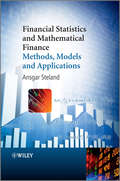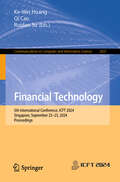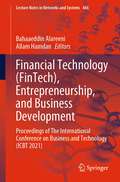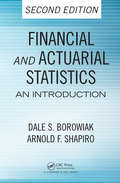- Table View
- List View
Financial Mathematics, Derivatives and Structured Products
by Raymond H. Chan Spike T. Lee Xun Li Yves ZY. GuoThis book introduces readers to the financial markets, derivatives, structured products and how the products are modelled and implemented by practitioners. In addition, it equips readers with the necessary knowledge of financial markets needed in order to work as product structurers, traders, sales or risk managers. As the book seeks to unify the derivatives modelling and the financial engineering practice in the market, it will be of interest to financial practitioners and academic researchers alike. Further, it takes a different route from the existing financial mathematics books, and will appeal to students and practitioners with or without a scientific background. The book can also be used as a textbook for the following courses: • Financial Mathematics (undergraduate level) • Stochastic Modelling in Finance (postgraduate level) • Financial Markets and Derivatives (undergraduate level) • Structured Products and Solutions (undergraduate/postgraduate level)
Financial Mathematics, Derivatives and Structured Products
by Raymond H. Chan Spike T. Lee Xun Li Yves ZY. GuoThis book introduces readers to the financial markets, derivatives, structured products and how the products are modelled and implemented by practitioners. In addition, it equips readers with the necessary knowledge of financial markets needed in order to work as product structurers, traders, sales or risk managers.This second edition substantially extends, updates and clarifies the previous edition. New materials and enhanced contents include, but not limited to, the role of central counterparties for derivatives transactions, the reference rates to replace LIBOR, risk-neutral modelling for futures and forward, discussions and analysis on risk-neutral framework and numéraires, discrete dividend modelling, variance reduction techniques for Monte Carlo method, finite difference method analysis, tree method, FX modelling, multi-name credit derivatives modelling, local volatility model, forward variance model and local-stochastic volatility model to reflect market practice.As the book seeks to unify the derivatives modelling and the financial engineering practice in the market, it will be of interest to financial practitioners and academic researchers alike. The book can also be used as a textbook for the following courses:• Financial Mathematics (undergraduate level)• Stochastic Modelling in Finance (postgraduate level)• Financial Markets and Derivatives (undergraduate level)• Structured Products and Solutions (undergraduate/postgraduate level)
Financial Mathematics, Volatility and Covariance Modelling: Volume 2 (Routledge Advances in Applied Financial Econometrics)
by Julien Chevallier Stéphane Goutte David Guerreiro Sophie Saglio Bilel SanhajiThis book provides an up-to-date series of advanced chapters on applied financial econometric techniques pertaining the various fields of commodities finance, mathematics & stochastics, international macroeconomics and financial econometrics. Financial Mathematics, Volatility and Covariance Modelling: Volume 2 provides a key repository on the current state of knowledge, the latest debates and recent literature on financial mathematics, volatility and covariance modelling. The first section is devoted to mathematical finance, stochastic modelling and control optimization. Chapters explore the recent financial crisis, the increase of uncertainty and volatility, and propose an alternative approach to deal with these issues. The second section covers financial volatility and covariance modelling and explores proposals for dealing with recent developments in financial econometrics This book will be useful to students and researchers in applied econometrics; academics and students seeking convenient access to an unfamiliar area. It will also be of great interest established researchers seeking a single repository on the current state of knowledge, current debates and relevant literature.
Financial Mathematics: A Comprehensive Treatment (Textbooks in Mathematics)
by Roman N. Makarov Giuseppe CampolietiVersatile for Several Interrelated Courses at the Undergraduate and Graduate Levels <P><P> Financial Mathematics: A Comprehensive Treatment provides a unified, self-contained account of the main theory and application of methods behind modern-day financial mathematics. Tested and refined through years of the authors’ teaching experiences, the book encompasses a breadth of topics, from introductory to more advanced ones. <P><P> Accessible to undergraduate students in mathematics, finance, actuarial science, economics, and related quantitative areas, much of the text covers essential material for core curriculum courses on financial mathematics. Some of the more advanced topics, such as formal derivative pricing theory, stochastic calculus, Monte Carlo simulation, and numerical methods, can be used in courses at the graduate level. Researchers and practitioners in quantitative finance will also benefit from the combination of analytical and numerical methods for solving various derivative pricing problems. <P><P> With an abundance of examples, problems, and fully worked out solutions, the text introduces the financial theory and relevant mathematical methods in a mathematically rigorous yet engaging way. Unlike similar texts in the field, this one presents multiple problem-solving approaches, linking related comprehensive techniques for pricing different types of financial derivatives. The book provides complete coverage of both discrete- and continuous-time financial models that form the cornerstones of financial derivative pricing theory. It also presents a self-contained introduction to stochastic calculus and martingale theory, which are key fundamental elements in quantitative finance.
Financial Mathematics: A Comprehensive Treatment in Continuous Time Volume II (Textbooks in Mathematics)
by Roman N. Makarov Giuseppe CampolietiThe book has been tested and refined through years of classroom teaching experience. With an abundance of examples, problems, and fully worked out solutions, the text introduces the financial theory and relevant mathematical methods in a mathematically rigorous yet engaging way. This textbook provides complete coverage of continuous-time financial models that form the cornerstones of financial derivative pricing theory. Unlike similar texts in the field, this one presents multiple problem-solving approaches, linking related comprehensive techniques for pricing different types of financial derivatives. Key features: In-depth coverage of continuous-time theory and methodology Numerous, fully worked out examples and exercises in every chapter Mathematically rigorous and consistent, yet bridging various basic and more advanced concepts Judicious balance of financial theory and mathematical methods Guide to Material This revision contains: Almost 150 pages worth of new material in all chapters A appendix on probability theory An expanded set of solved problems and additional exercises Answers to all exercises This book is a comprehensive, self-contained, and unified treatment of the main theory and application of mathematical methods behind modern-day financial mathematics. The text complements Financial Mathematics: A Comprehensive Treatment in Discrete Time, by the same authors, also published by CRC Press.
Financial Mathematics: A Comprehensive Treatment in Discrete Time (Chapman and Hall/CRC Financial Mathematics Series)
by Roman N. Makarov Giuseppe CampolietiThe book has been tested and refined through years of classroom teaching experience. With an abundance of examples, problems, and fully worked out solutions, the text introduces the financial theory and relevant mathematical methods in a mathematically rigorous yet engaging way. This textbook provides complete coverage of discrete-time financial models that form the cornerstones of financial derivative pricing theory. Unlike similar texts in the field, this one presents multiple problem-solving approaches, linking related comprehensive techniques for pricing different types of financial derivatives. Key features: In-depth coverage of discrete-time theory and methodology. Numerous, fully worked out examples and exercises in every chapter. Mathematically rigorous and consistent yet bridging various basic and more advanced concepts. Judicious balance of financial theory, mathematical, and computational methods. Guide to Material. This revision contains: Almost 200 pages worth of new material in all chapters. A new chapter on elementary probability theory. An expanded the set of solved problems and additional exercises. Answers to all exercises. This book is a comprehensive, self-contained, and unified treatment of the main theory and application of mathematical methods behind modern-day financial mathematics. Table of Contents List of Figures and Tables Preface I Introduction to Pricing and Management of Financial Securities 1 Mathematics of Compounding2 Primer on Pricing Risky Securities 3 Portfolio Management 4 Primer on Derivative Securities II Discrete-Time Modelling 5 Single-Period Arrow–Debreu Models 6 Introduction to Discrete-Time Stochastic Calculus 7 Replication and Pricing in the Binomial Tree Model 8 General Multi-Asset Multi-Period Model Appendices A Elementary Probability Theory B Glossary of Symbols and Abbreviations C Answers and Hints to Exercises References Index Biographies Giuseppe Campolieti is Professor of Mathematics at Wilfrid Laurier University in Waterloo, Canada. He has been Natural Sciences and Engineering Research Council postdoctoral research fellow and university research fellow at the University of Toronto. In 1998, he joined the Masters in Mathematical Finance as an instructor and later as an adjunct professor in financial mathematics until 2002. Dr. Campolieti also founded a financial software and consulting company in 1998. He joined Laurier in 2002 as Associate Professor of Mathematics and as SHARCNET Chair in Financial Mathematics. Roman N. Makarov is Associate Professor and Chair of Mathematics at Wilfrid Laurier University. Prior to joining Laurier in 2003, he was an Assistant Professor of Mathematics at Siberian State University of Telecommunications and Informatics and a senior research fellow at the Laboratory of Monte Carlo Methods at the Institute of Computational Mathematics and Mathematical Geophysics in Novosibirsk, Russia.
Financial Mathematics: Exercises and Solutions (Springer Texts in Business and Economics)
by Peter Brusov Tatiana Filatova Natali OrekhovaThis textbook is designed to facilitate a thorough learning for students of financial mathematics. It includes exercises and theoretical questions across seven chapters: Interest Theory, Financial Flows and Annuities, Profitability and Risk of Financial Operations, Portfolio Analysis, Bonds, Modigliani-Miller Theory, and Brusov-Filatova-Orekhova Theory. The last two chapters are dedicated to modern theories of capital structure, including problems and tasks. More than 130 detailed solutions are provided to help students solve the assignments in the textbook. This textbook is suitable for undergraduate and graduate students in all financial and economic fields, including finance and credit, accounting and auditing, taxes, insurance, and international economic relations. It is also useful for professionals in financial and economic specialties, including financial analysts, as well as anyone interested in mastering quantitative methods in finance and economics.
Financial Mathematics: From Discrete to Continuous Time (Chapman and Hall/CRC Financial Mathematics Series)
by Kevin J. HastingsFinancial Mathematics: From Discrete to Continuous Time is a study of the mathematical ideas and techniques that are important to the two main arms of the area of financial mathematics: portfolio optimization and derivative valuation. The text is authored for courses taken by advanced undergraduates, MBA, or other students in quantitative finance programs. The approach will be mathematically correct but informal, sometimes omitting proofs of the more difficult results and stressing practical results and interpretation. The text will not be dependent on any particular technology, but it will be laced with examples requiring the numerical and graphical power of the machine. The text illustrates simulation techniques to stand in for analytical techniques when the latter are impractical. There will be an electronic version of the text that integrates Mathematica functionality into the development, making full use of the computational and simulation tools that this program provides. Prerequisites are good courses in mathematical probability, acquaintance with statistical estimation, and a grounding in matrix algebra. The highlights of the text are: A thorough presentation of the problem of portfolio optimization, leading in a natural way to the Capital Market Theory Dynamic programming and the optimal portfolio selection-consumption problem through time An intuitive approach to Brownian motion and stochastic integral models for continuous time problems The Black-Scholes equation for simple European option values, derived in several different ways A chapter on several types of exotic options Material on the management of risk in several contexts
Financial Mathematics: Theory and Problems for Multi-period Models
by Wolfgang J. Runggaldier Andrea PascucciWith the Bologna Accords a bachelor-master-doctor curriculum has been introduced in various countries with the intention that students may enter the job market already at the bachelor level. Since financial Institutions provide non negligible job opportunities also for mathematicians, and scientists in general, it appeared to be appropriate to have a financial mathematics course already at the bachelor level in mathematics. Most mathematical techniques in use in financial mathematics are related to continuous time models and require thus notions from stochastic analysis that bachelor students do in general not possess. Basic notions and methodologies in use in financial mathematics can however be transmitted to students also without the technicalities from stochastic analysis by using discrete time (multi-period) models for which general notions from Probability suffice and these are generally familiar to students not only from science courses, but also from economics with quantitative curricula. There do not exists many textbooks for multi-period models and the present volume is intended to fill in this gap. It deals with the basic topics in financial mathematics and, for each topic, there is a theoretical section and a problem section. The latter includes a great variety of possible problems with complete solution.
Financial Microeconometrics: A Research Methodology in Corporate Finance and Accounting
by Marek GruszczyńskiThis book explores new topics in modern research on empirical corporate finance and applied accounting, especially the econometric analysis of microdata. Dubbed “financial microeconometrics” by the author, this concept unites both methodological and applied approaches. The book examines how quantitative methods can be applied in corporate finance and accounting research in order to predict companies getting into financial distress. Presented in a clear and straightforward manner, it also suggests methods for linking corporate governance to financial performance, and discusses what the determinants of accounting disclosures are. Exploring these questions by way of numerous practical examples, this book is intended for researchers, practitioners and students who are not yet familiar with the variety of approaches available for data analysis and microeconometrics.“This book on financial microeconometrics is an excellent starting point for research in corporate finance and accounting. In my view, the text is positioned between a narrative and a scientific treatise. It is based on a vast amount of literature but is not overloaded with formulae. My appreciation of financial microeconometrics has very much increased. The book is well organized and properly written. I enjoyed reading it.” Wolfgang Marty, Senior Investment Strategist, AgaNola AG
Financial Modeling
by Stéphane CrépeyBackward stochastic differential equations (BSDEs) provide a general mathematical framework for solving pricing and risk management questions of financial derivatives. They are of growing importance for nonlinear pricing problems such as CVA computations that have been developed since the crisis. Although BSDEs are well known to academics, they are less familiar to practitioners in the financial industry. In order to fill this gap, this book revisits financial modeling and computational finance from a BSDE perspective, presenting a unified view of the pricing and hedging theory across all asset classes. It also contains a review of quantitative finance tools, including Fourier techniques, Monte Carlo methods, finite differences and model calibration schemes. With a view to use in graduate courses in computational finance and financial modeling, corrected problem sets and Matlab sheets have been provided. Stéphane Crépey's book starts with a few chapters on classical stochastic processes material, and then... fasten your seatbelt... the author starts traveling backwards in time through backward stochastic differential equations (BSDEs). This does not mean that one has to read the book backwards, like a manga! Rather, the possibility to move backwards in time, even if from a variety of final scenarios following a probability law, opens a multitude of possibilities for all those pricing problems whose solution is not a straightforward expectation. For example, this allows for framing problems like pricing with credit and funding costs in a rigorous mathematical setup. This is, as far as I know, the first book written for several levels of audiences, with applications to financial modeling and using BSDEs as one of the main tools, and as the song says: "it's never as good as the first time". Damiano Brigo, Chair of Mathematical Finance, Imperial College London While the classical theory of arbitrage free pricing has matured, and is now well understood and used by the finance industry, the theory of BSDEs continues to enjoy a rapid growth and remains a domain restricted to academic researchers and a handful of practitioners. Crépey's book presents this novel approach to a wider community of researchers involved in mathematical modeling in finance. It is clearly an essential reference for anyone interested in the latest developments in financial mathematics. Marek Musiela, Deputy Director of the Oxford-Man Institute of Quantitative Finance
Financial Modeling, Actuarial Valuation and Solvency in Insurance
by Mario V. Wüthrich Michael MerzRisk management for financial institutions is one of the key topics the financial industry has to deal with. The present volume is a mathematically rigorous text on solvency modeling. Currently, there are many new developments in this area in the financial and insurance industry (Basel III and Solvency II), but none of these developments provides a fully consistent and comprehensive framework for the analysis of solvency questions. Merz and Wüthrich combine ideas from financial mathematics (no-arbitrage theory, equivalent martingale measure), actuarial sciences (insurance claims modeling, cash flow valuation) and economic theory (risk aversion, probability distortion) to provide a fully consistent framework. Within this framework they then study solvency questions in incomplete markets, analyze hedging risks, and study asset-and-liability management questions, as well as issues like the limited liability options, dividend to shareholder questions, the role of re-insurance, etc. This work embeds the solvency discussion (and long-term liabilities) into a scientific framework and is intended for researchers as well as practitioners in the financial and actuarial industry, especially those in charge of internal risk management systems. Readers should have a good background in probability theory and statistics, and should be familiar with popular distributions, stochastic processes, martingales, etc.
Financial Modelling with Jump Processes (Chapman and Hall/CRC Financial Mathematics Series)
by Rama Cont Peter TankovWINNER of a Riskbook.com Best of 2004 Book Award!During the last decade, financial models based on jump processes have acquired increasing popularity in risk management and option pricing. Much has been published on the subject, but the technical nature of most papers makes them difficult for nonspecialists to understand, and the mathematic
Financial Models in Production (SpringerBriefs in Finance)
by Adil Reghai Othmane KettaniThis book provides a hands-on guide to how financial models are actually implemented and used in practice, on a daily basis, for pricing and risk-management purposes. It shows how to put these models into use in production while minimizing the cost of implementation and maximizing robustness and control. Addressing some of the most important and cutting-edge issues, it describes how to build the necessary models in order to risk manage all the costs involved in options fabrication within the world of equity derivatives and hybrids. This is achieved by extending classical models and improving them in order to account for complex features. The book is primarily aimed at market practitioners (traders, risk managers, risk control, top managers), as well as Masters students in Quantitative/Mathematical Finance. It will also be useful for instructors hoping to enrich their courses with practical examples. The prerequisites are basic stochastic calculus and a general knowledge of financial markets and financial derivatives.
Financial Numeracy in Mathematics Education: Research and Practice (Mathematics Education in the Digital Era #15)
by Annie Savard Alexandre CavalcanteThis book presents the important role of mathematics in the teaching of financial education. Through a conceptualization of financial numeracy as a social practice, it focuses on the teaching practices, resources, and needs of secondary mathematics teachers (grades 7-12) to incorporate financial concepts in their classes. The editors and authors bring forth a novel perspective regarding mathematics education in the digital era. By focusing on financial numeracy, a key component of skills required in the digital era, they discuss important issues related to the teaching and learning of mathematics and finance. In contrary to most research in the field of financial education coming from scholars in areas such as business, accounting, management and economics, this book introduces the contribution of researchers from the field of education to the debate. The book appeals to an international audience composed of researchers, stakeholders, policymakers, teachers, and teacher educators.
Financial Risk Management and Modeling (Risk, Systems and Decisions)
by Constantin Zopounidis Ramzi Benkraiem Iordanis KalaitzoglouRisk is the main source of uncertainty for investors, debtholders, corporate managers and other stakeholders. For all these actors, it is vital to focus on identifying and managing risk before making decisions. The success of their businesses depends on the relevance of their decisions and consequently, on their ability to manage and deal with the different types of risk. Accordingly, the main objective of this book is to promote scientific research in the different areas of risk management, aiming at being transversal and dealing with different aspects of risk management related to corporate finance as well as market finance. Thus, this book should provide useful insights for academics as well as professionals to better understand and assess the different types of risk.
Financial Risk Management for Cryptocurrencies (SpringerBriefs in Finance)
by Wim Schoutens Lucia Alessi Eline Van der Auwera Marco Petracco GiudiciThis book explores the emerging field of risk management and risk analysis of cryptocurrencies, an area that has been generating considerable research. It begins by providing an introduction to digital finance and the concept of cryptocurrencies and blockchain technologies. It then describes in detail the intrinsic risks involved in cryptocurrencies, an area that, to date, has not been fully documented or investigated. Lastly, it discusses the various types of risk, with a focus on design, operational, market and quantitative risks.Providing insights into the analysis and management of cryptocurrencies, and serving as a starting point for a more in-depth risk analysis, this book will appeal to professionals and researchers interested in familiarizing themselves with the risks in cryptocurrencies, including academics, portfolio managers, risk-managers, quants, financial professionals, regulators, economists, asset managers and traders.
Financial Risk Modelling and Portfolio Optimization with R
by Bernhard PfaffIntroduces the latest techniques advocated for measuring financial market risk and portfolio optimization, and provides a plethora of R code examples that enable the reader to replicate the results featured throughout the book.Financial Risk Modelling and Portfolio Optimization with R:Demonstrates techniques in modelling financial risks and applying portfolio optimization techniques as well as recent advances in the field.Introduces stylized facts, loss function and risk measures, conditional and unconditional modelling of risk; extreme value theory, generalized hyperbolic distribution, volatility modelling and concepts for capturing dependencies.Explores portfolio risk concepts and optimization with risk constraints.Enables the reader to replicate the results in the book using R code.Is accompanied by a supporting website featuring examples and case studies in R.Graduate and postgraduate students in finance, economics, risk management as well as practitioners in finance and portfolio optimization will find this book beneficial. It also serves well as an accompanying text in computer-lab classes and is therefore suitable for self-study.
Financial Risk Modelling and Portfolio Optimization with R (Statistics in Practice)
by Bernhard PfaffIntroduces the latest techniques advocated for measuring financial market risk and portfolio optimization, and provides a plethora of R code examples that enable the reader to replicate the results featured throughout the book. Financial Risk Modelling and Portfolio Optimization with R: Demonstrates techniques in modelling financial risks and applying portfolio optimization techniques as well as recent advances in the field. Introduces stylized facts, loss function and risk measures, conditional and unconditional modelling of risk; extreme value theory, generalized hyperbolic distribution, volatility modelling and concepts for capturing dependencies. Explores portfolio risk concepts and optimization with risk constraints. Enables the reader to replicate the results in the book using R code. Is accompanied by a supporting website featuring examples and case studies in R. Graduate and postgraduate students in finance, economics, risk management as well as practitioners in finance and portfolio optimization will find this book beneficial. It also serves well as an accompanying text in computer-lab classes and is therefore suitable for self-study.
Financial Software Engineering (Undergraduate Topics in Computer Science)
by Kevin Lano Howard HaughtonIn this textbook the authors introduce the important concepts of the financial software domain, and motivate the use of an agile software engineering approach for the development of financial software. They describe the role of software in defining financial models and in computing results from these models. Practical examples from bond pricing, yield curve estimation, share price analysis and valuation of derivative securities are given to illustrate the process of financial software engineering.Financial Software Engineering also includes a number of case studies based on typical financial engineering problems:*Internal rate of return calculation for bonds* Macaulay duration calculation for bonds* Bootstrapping of interest rates* Estimation of share price volatility* Technical analysis of share prices* Re-engineering Matlab to C#* Yield curve estimation* Derivative security pricing* Risk analysis of CDOs The book is suitable for undergraduate and postgraduate study, and for practitioners who wish to extend their knowledge of software engineering techniques for financial applications
Financial Statements-Based Bank Risk Aggregation (Innovation in Risk Analysis)
by Jianping Li Lu Wei Xiaoqian ZhuThis book proposes a bank risk aggregation framework based on financial statements. Specifically, bank risk aggregation is of great importance to maintain stable operation of banking industry and prevent financial crisis. A major obstacle to bank risk management is the problem of data shortage, which makes many quantitative risk aggregation approaches typically fail. Recently, to overcome the problem of inaccurate total risk results caused by the shortage of risk data, some researchers have proposed a series of financial statements-based bank risk aggregation approaches. However, the existing studies have drawbacks of low frequency and time lag of financial statements data and usually ignore off-balance sheet business risk in bank risk aggregation. Thus, by reviewing the research progress in bank risk aggregation based on financial statements and improving the drawbacks of existing methods, this book proposes a bank risk aggregation framework based on financial statements. It makes full use of information recorded in financial statements, including income statement, on- and off-balance sheet assets, and textual risk disclosures, which solves the problem of data shortage in bank risk aggregation to some extent and improves the reliability and rationality of bank risk aggregation results. This book not only improves the theoretical studies of bank risk aggregation, but also provides an important support for the capital allocation of the banking industry in practice. Thus, this book has theoretical and practical importance for bank managers and researchers of bank risk management.
Financial Statistics and Mathematical Finance: Methods, Models and Applications
by Ansgar StelandMathematical finance has grown into a huge area of research which requires a lot of care and a large number of sophisticated mathematical tools. Mathematically rigorous and yet accessible to advanced level practitioners and mathematicians alike, it considers various aspects of the application of statistical methods in finance and illustrates some of the many ways that statistical tools are used in financial applications.Financial Statistics and Mathematical Finance:Provides an introduction to the basics of financial statistics and mathematical finance.Explains the use and importance of statistical methods in econometrics and financial engineering.Illustrates the importance of derivatives and calculus to aid understanding in methods and results.Looks at advanced topics such as martingale theory, stochastic processes and stochastic integration.Features examples throughout to illustrate applications in mathematical and statistical finance.Is supported by an accompanying website featuring R code and data sets.Financial Statistics and Mathematical Finance introduces the financial methodology and the relevant mathematical tools in a style that is both mathematically rigorous and yet accessible to advanced level practitioners and mathematicians alike, both graduate students and researchers in statistics, finance, econometrics and business administration will benefit from this book.
Financial Technology: 5th International Conference, ICFT 2024, Singapore, September 23–25, 2024, Proceedings (Communications in Computer and Information Science #2437)
by Qi Cao Ruidan Su Ke-Wei HuangThis book constitutes the proceedings of the 5th International Conference on Financial Technology, ICFT 2024, held in Singapore during September 23–25, 2024. The 17 full papers presented in this volume were carefully reviewed and selected from 35 submissions. These papers focus on the current research in Blockchain technology, Financial technology and the application of Artificial Intelligence in these areas.
Financial Technology: Proceedings of The International Conference on Business and Technology (ICBT 2021) (Lecture Notes in Networks and Systems #486)
by Allam Hamdan Bahaaeddin AlareeniThis book constitutes the refereed proceedings of the International Conference on Business and Technology (ICBT2021) organized by EuroMid Academy of Business & Technology (EMABT), held in Istanbul, between 06–07 November 2021. In response to the call for papers for ICBT2021, 485 papers were submitted for presentation and inclusion in the proceedings of the conference. After a careful blind refereeing process, 292 papers were selected for inclusion in the conference proceedings from forty countries. Each of these chapters was evaluated through an editorial board, and each chapter was passed through a double-blind peer-review process.The book highlights a range of topics in the fields of technology, entrepreneurship, business administration, accounting, and economics that can contribute to business development in countries, such as learning machines, artificial intelligence, big data, deep learning, game-based learning, management information system, accounting information system, knowledge management, entrepreneurship, and social enterprise, corporate social responsibility and sustainability, business policy and strategic management, international management and organizations, organizational behavior and HRM, operations management and logistics research, controversial issues in management and organizations, turnaround, corporate entrepreneurship, innovation, legal issues, business ethics, and firm governance, managerial accounting and firm financial affairs, non-traditional research, and creative methodologies.These proceedings are reflecting quality research contributing theoretical and practical implications, for those who are wise to apply the technology within any business sector. It is our hope that the contribution of this book proceedings will be of the academic level which even decision-makers in the various economic and executive-level will get to appreciate.
Financial and Actuarial Statistics: An Introduction, Second Edition
by Dale S. Borowiak Arnold F. ShapiroUnderstand Up-to-Date Statistical Techniques for Financial and Actuarial ApplicationsSince the first edition was published, statistical techniques, such as reliability measurement, simulation, regression, and Markov chain modeling, have become more prominent in the financial and actuarial industries. Consequently, practitioners and students must ac
